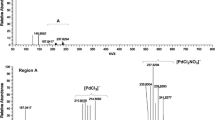Abstract
Liquid-liquid extraction of Ni(II) ion by Kelex 100 and 8-sulfonamidoquinolines in chlorobenzene was studied at 25°C. The extraction equilibrium was established only slowly, requiring generally 24 h mechanical shaking. The extractants (HL) behaved as bidentate monoanionic chelating ligands, forming 1:2 (Ni2+:L-) complexes on metal extraction. The overall extraction constants (log Kexi; Kex=[NiL2]org[H+]2aq/[Ni2+]aq[HL]2org were in the order of −6 for Kelex 100 and in the range of −8–10 for 8-sulfonamidoquinolines depending on the nature of organic sulfonyl groups. A small synergistic effect by trioctylphosphine oxide, 4-benzylpyridine and 6-nitroquinoline as well as by Kelex 100 itself was observed in the extraction by Kelex 100.
Similar content being viewed by others
References
A. W, Ashbrook, Hydrometallwgy, 1, 93 (1975).
A. W. Ashbrook, J. Chromatogr., 105, 151 (1975).
G. M. Ricety, CM Bull, 75, April (1973).
G. M. Ritcey and B. H. Lucas, CIM Bull., 87, Feb. (1974).
G. M. Ritcey and B. H. Lucas, CIM Bull., 105, Feb (1975).
D. S. Flett, J. A. Hartlage, D. R. Spink and D. N. Okuhara, J. Inorg. Nucl. Chem., 37, 1967 (1975).
V. I. Lakshmanan and G. J. Lawson, J. Inorg. Nucl. Chem., 35, 4285 (1973).
G. Harrison, V. I. Lakshmanan and G. J. Lawson, Hydrometallwgy, 1, 339 (1976).
M. J. Virnig, Proceedings of the International Solvent Extraction Conference, 1977, p. 536 (1979).
M. Takagi, T. Omori, S. Mathuo, K. Ueno and S. Ide, Chem. Lett., 1980, 387.
S. Ide, T. Yoshida, S. Mathuno, M. Takagi and K. Ueno, Anal. Chim. Acta, 149, 235 (1983), and references cited therein.
H. Nakamura, T. Yoshida, M. Todoko, K. Ueno and M. Takagi, Bull Chem. Soc Jpn., 57, 2839 (1984).
K. Yoshizuka, K. Kondo and F. Nakashio, J. Chem. Eng. Jpn., 18, 383 (1985).
K. Yoshizuka, K. Kondo and F. Nakashio, J. Chem. Eng. Jpn., 18, 383 (1985).
The a values are very sensitive to the experimental errors involved in the data points at low or high metal extraction ratios (i.e., D<0.2 or D>5). Therefore, α values and standard deviations of the linear plots can serve as a useful measure of equilibrium attainment. On the other hand, the half extraction pH (pH at D=1) are usually not so sensitive to small errors due to unequilibration as are seen in Table 1.
It was at first suspected that a values lower than 2 indicated co-extraction of other anionic species in solution such as NO3- and Cl-. However, as subsequent study indicated, the use of excess NO3-, Br- or CH3CO2- did not cause any alteration in the basic extraction behavior of Ni(II) ion. Therefore, it was concluded that the metal was extracted solely with proton-dissociated extractant molecule as counter anion. It was also studied about the possibility that low a values were caused by the formation of hydrated metal complex NiL2(H2O)2 and its dissolution in aqueous solution. However, the metal extraction generally reached -100% in the present study, and thus such a factor could not satisfactorily explain the observed experimental facts. Theoretically, the involvement of water-soluble complex can affect the slope only slightly (moreover, it tends to increase the slope rather than decrease).
In this calculation, the formation of adduct complexes (n>/1 in equation I) was neglected. In fact the extent of adduct formation under the conditions of Table 1 was estimated to be rather low (see below and note 21).
Yu. A. Zolotov, N. M. Kuzumin, V. G. Lambrev and Tr. Komis. Po, Analit. Khim. Akad. Nauk SSSR. 15, 51 (1965).
N. M. Kuzumin and Yu. A. Zolotov, Zh. Neorg. Khim., 11, 2316 (1966).
V. V. Bagreer and Yu. A. Zolotov, Zh Neorg. Khim., 20, 867 (1965).
H. Akaiwa, H. Kawamoto and M. Hara, Nihonkagakukaishi, 90, 186 (1969).
Theoretical and model calculations predicted that the plots of pH1/2vs. −log[HL]org gave a straight line with a slope between 1 and 1.5 when the number of neutral ligands within the adduct is limited to 1 (n= 1 in reaction 1). Then, a calculation further indicated that the observed slope 1.2 corresponded to the value of equilibrium constant of adduct formation, K(K= [NiL2·HL]org/([NiL2]org·[HL]org), of around 10. If this value is adopted for K, then the extent of adduct complex formation in the organic phase under typical extraction conditions in Table 1 is in the order of 10–20%.
Author information
Authors and Affiliations
Rights and permissions
About this article
Cite this article
Ide, S., Takagi, M. Solvent Extraction of Nickel(II) with Kelex 100 and 8-Sulfonamidoquinolines. ANAL. SCI. 2, 265–269 (1986). https://doi.org/10.2116/analsci.2.265
Received:
Accepted:
Published:
Issue Date:
DOI: https://doi.org/10.2116/analsci.2.265




